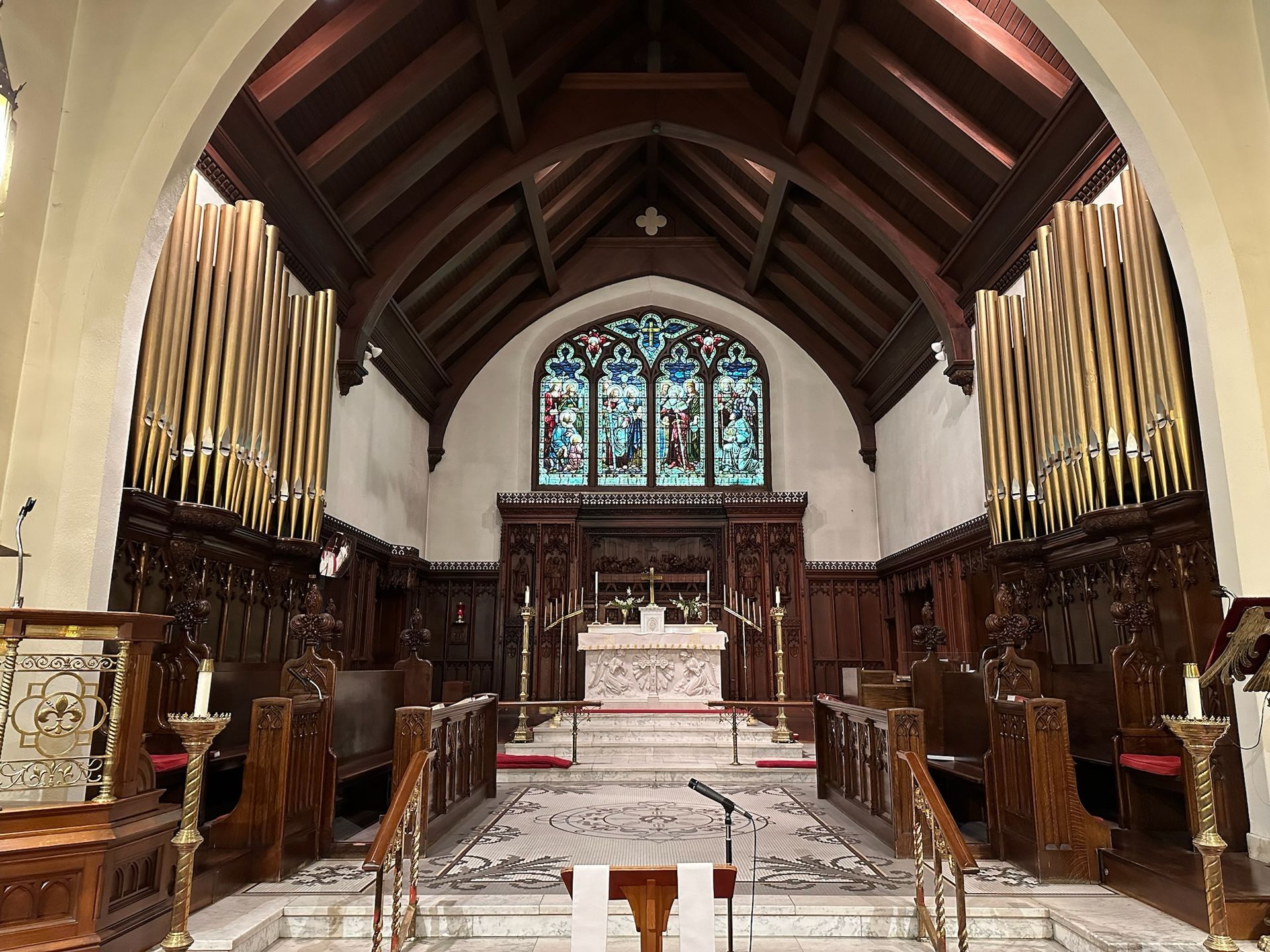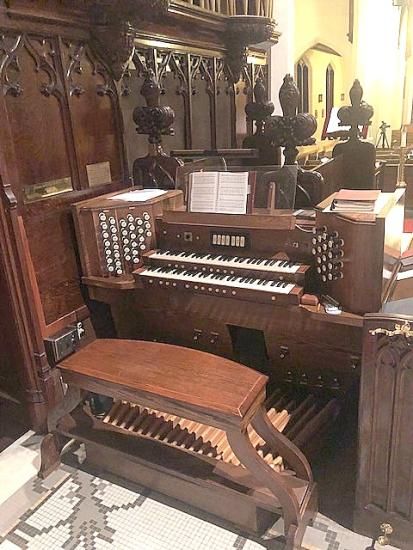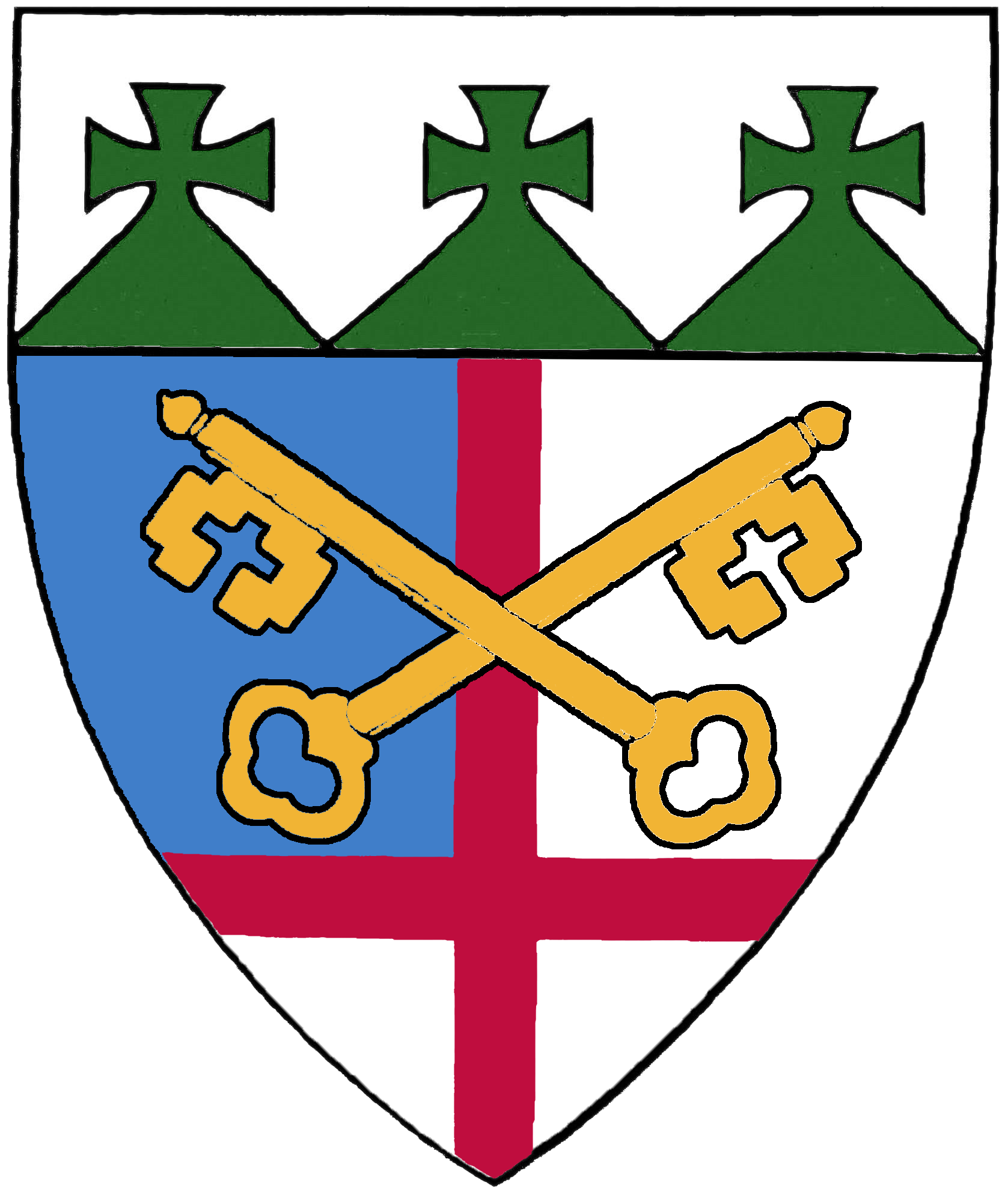The Harry Wills Memorial Organ
The pipe organ at St. Peter’s is a two-manual instrument with 901 pipes and 13 ranks, the culmination of work by several different organ builders over a period of about 150 years.
650 E and GG Hook, 1864 (cost $1,650)
The pipe organ at St Peter’s Episcopal Church in downtown Bennington, Vermont, is actually a culmination of several different organ builders spanning approximately 150 years. The earliest pipes in the current organ belong to the 2-manual E. & G. G. Hook organ from the previous church, Opus 370, installed in 1865. The colorfully painted facade pipes still exist as part of the Great Organ, and original wooden pedal pipes still bear the original markings of Mr. Hook, just as he labeled them prior to installation.
In 1865, the E &G.G. Hook Brothers of Boston, Ma, furnished a pipe organ to St Peter’s Episcopal Church, Bennington; it was their Opus 370, a two –manual, mechanical-action organ of 17 registers, consigned to the Rev. D.S. Phillips. The first instrument was built for the red brick church and was
installed in the tower room over the liturgical west front (Pleasant Street end) of the church. When the red brick church building was razed in 1907, the entire organ was dismantled and stored while the new church building was erected (1907-1909). The organ was installed in the new stone church in the area that now is at the rear of the choir stalls on the Gospel side.
The E & GG Hook instrument had completely mechanical linkage (tracker action) and so the keyboards and pedals (console) had to be located in the corridor outside the working sacristy to allow for the physical connection of the console to the organ. The organist actually sat outside the choir area.
That instrument served intact until the 1930’s.


Estey Organ Company, 1938
In 1932 the organ underwent a large overhaul by the Estey Organ Company of Brattleboro, Vermont. At that point, a new console (where the organist sits) was rebuilt and many new ranks of pipes were added to increase the dynamic flexibility of the instrument. The Estey Organ Opus # 3105 was installed in 1938 at St. Peter’s Episcopal Church, a gift of Lieutenant Governor William Wills, incorporating the pipes of the 1864 E & GG Hook instrument.
The Harry Wills Memorial Organ, the Estey Organ, was given by then Lieutenant Governor William Wills in memory of his brother Harry Wills, who had died in 1937. The Wills Organ was dedicated on December 17, 1939. It was housed in the left rear (northeast) corner of the chapel, changed from the location of the E & GG Hook instrument which was housed in a little room to the left of the altar (as one faces the altar).
When the Estey organ was installed, all pipes were located behind the choir stalls on the Gospel side of the church. The electro-pneumatic action of the Estey organ allowed the console to be detached and placed on the Lady Chapel (Epistle) side of the church.
M. R. Resig Associates, 1985
In 1985, MR Resig Associates, organ builders, completed a partial mechanical rebuilding of the St. Peter’s pipe organ. This work included tonal improvements and the adding of an oboe (hautboy). In 1985, the console was moved to its present location at the north end of the choir rows on the Epistle side of the church. This marked the first time that the organist could actually hear the organ and the balance of the sound with the choir. The E & GG Hook and the Estey Organ pipes still remain as the foundation of the St. Peter’s pipe organ.
Southfield Organ Works, 1996
In 1996, Southfield Organ Builders from Springfield, Massachusetts, were engaged to perform a complete mechanical rebuilding of the St. Peter’s organ. Southfield continues to be the firm engaged to complete periodic touch-ups and small improvements.
In the evening of Sunday, September 4, 2011 the ground outside of St Peter’s Episcopal Church was struck by a very powerful lightning bolt. This electrical strike damaged many items at the church including computers, modems, telephones and telephone lines, and the primary electrical system on the organ. The organ remained out of service from September 4th until December 6, 2011. Many repairs were made, including replacement of entire electrical boards, hundreds of transistors and diodes and various pieces of wiring from the electronic ‘brain’ of the organ in the basement all the way up to the Solid State Logic control systems in the console. Immediately after finishing this project, it was found that the blower (small turbine that supplies the organ with wind) was also in serious need of repair. Both the electrical motor and the impels were repaired and it is now in fully operational condition, supplying plenty of wind to the organ.
From the very beginning, music has been part of the fabric of life at St. Peter’s Episcopal Church. The first organ, an E. and G.G. Hook instrument, was installed in 1864 in the first St. Peter’s Church building. The Estey organ was installed in the present stone church in 1938, incorporating most of the older instrument. The musical heritage of the Episcopal Church has been extensive and diverse throughout the years.
As part of the Cornerstone Centennial Celebration. St Peter’s hosted The Wills Memorial Pipe Organ Concert Series, in early 2008. John Riddle, Randall Krum and Anne Marcure played for this 3-concert series on Sundays at 3pm. Tickets were $20 for the three concerts.
St. Peter’s Organists & Choirmasters
- James Fry (2023-2024)
- John Riddle
- John Terauds
- Randall Krum (2004 – 2008)
- Anne Marcure (2001-2003)
- Alan Walker (1993-2001)
- Randall Krum (1984-1992)
- John Riddle (1969-1984)
- Ogden “Spike” Knapp substituted occasionally in the 1970’s
- Stanley Pike (1947-1969)
- Herb Sanderson, substituted occasionally in the 1960’s
- Clarence Hard (1930-1940’s)
- (Frank Hurley, choir director)
- Frank Butcher – from Hoosac School – organist for August, 1943
- Rudolph Oliver Goldsmith (1862-1905) choirmaster in the brick church
- Miss Frances Stillson – 1888 – organist in the brick church with the E & GG Hook organ
St. Peter’s Pipe Organ Specifications (2007)
Great
Violoncello 16 (extension of Gemshorn 8')
Open Diapason 8'
Major Flute 8'
Harmonic Flute 8'
Gemshorn 8'
Octave 4'
Chimney Flute 4' (extension of Major Flute')
Twelfth 2 2/3'
Fifteenth 2' (extension of Octave 4')
Mixture III 1 1/3'
Tuba 8'
Clarion 4 (extension of Tuba 8')
Bell Star
Swell
Stpd Diapason 8'
Concert Flute 8'
Viola 8'
Celeste 8' TC (tuned flat)
Principal 4'
Night Horn 4' (extension of Concert Flute 8')
Nazard 2 2/3' (extension of Viola 8')
Block Flute 2' (extension of Stopped Diapason 8')
Octave 2' (ext Principal)
Seventeenth 1 3/5' (extension of Celeste 8')
Nineteenth 1 1/3' (extension of Viola 8')
Fife 1' (extension of Stopped Diapason 8')
Bassoon 16' (extension of Hautboy 8')
Hautboy 8'
Tremolo
Pedal
Resultant 32'
Double Diapason 16' (extension of Great Octave)
Sub Bass 16'
Violone 16' (from Great)
Octave 8' (ext Great Octave)
Bass Flute 8' (extension of Sub Bass)
Cello 8' (from Great Gemshorn)
Super Octave 4' (Great Octave)
Still Flute 4' (extension of Sub Bass)
Harmonics III
Trombone 16' (extension of Great Tuba)
Bassoon 16' (from Swell)
Tromba 8' (from Great Tuba)
Clarion 4' (from Great Tuba)
Couplers
Swell: 16', Unison Off, 4'; Swell to Great: 16’, 8’, 4’;
Swell and Great to Pedal: 8' and 4'
Combinations on 8 levels of memory
Generals: 6; Swell: 5; Great: 5; Pedal: 4
Visit the Organ Historical Society for more information
https://organhistoricalsociety.org/estey/Opus3105.htm

